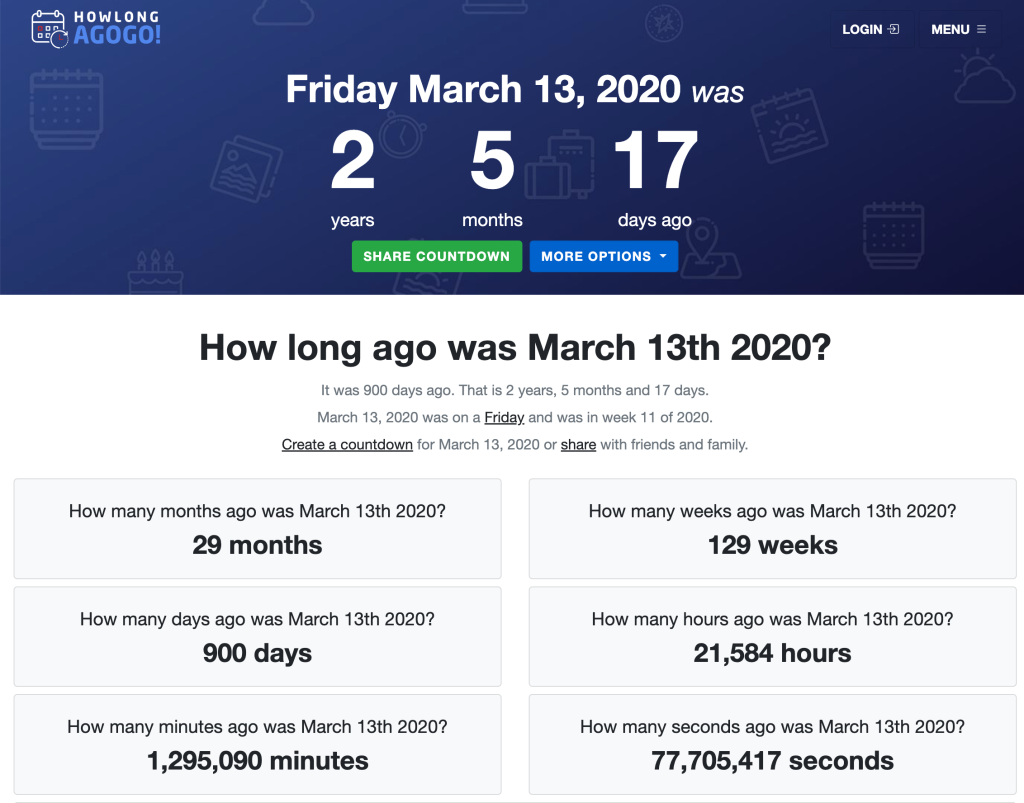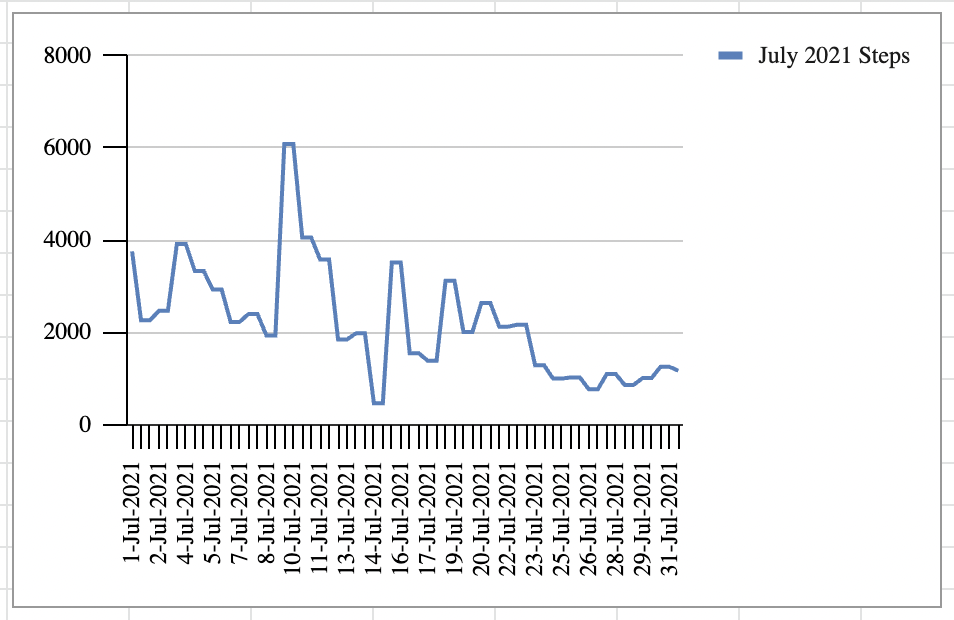
BACK THEN
It’s been a while since I’ve talked about my Long COVID journey here, but this nice round number was too tempting to pass up. 900 days since I came down with COVID, and still trying to recover. Who knows? You might get another post for day 1000. I’m fairly confident this won’t be gone and resolved by then. What’s the news? I’m a lot better … and … not really. It’s still a roller coaster, still good days and bad days.
Early in my recovery I was very proactive, got a diagnosis of dysautonomia way ahead of the curve because I had the symptoms, but really because I tracked down trends in the UK and my doc listened to me, so we knew what to look for. I also had a lot of really on target help and therapy early on, for the same reasons, and was able to get into neuro–rehab in October 2020 instead of the graded exercise programs that have broken so many people. I was told that to be able to work regularly on-site I’d need to be able to tolerate 5000 steps a day without triggering a crash. By February/March 2021 I was plateaued, and not making further progress. I also kept experiencing crashes, although they were a lot smaller and less often. We decided I needed more rest time to REALLY recover and make it to the next level. And that meant HR got involved, because I needed to access my extended sick leave. [Note: “HR” here is shorthand for the specific unit involved in this oversight, not “human resources.”] By April/May 2021 I was almost there, tolerating 5000 steps a day 3 days a week. This meant I was able to walk around the block I live on twice a day, once in the morning, once in the evening. Each circuit of the block was a half mile.
I was so excited, but HR decided I wasn’t recovering fast enough, and pressured me to switch from the neuro rehab to a program they selected. The case manager promised the other program had more resources, more monitors, more tracking, more everything than what I’d been able to access. I consulted with my team, and reluctantly made the switch, only to discover it had less resources, less tracking, etc. The poor therapist was managing 3 patients within each visit slot, switching from person to person and sending gofer assistants with instructions. Within a month of starting in the new program, I was completely broken, back to ground zero, starting over. The day that triggered all the problems, I didn’t see my therapist until the end of the session, it was all just gofers, who had me do .75 mile on one machine and .5 mile on a second machine within just over half an hour. You can see the crash on this chart. (You can get your own charts like these in a Long COVID toolkit I’m putting together [next LC post], but for now here’s a link to the blanks in Google Drive. Thanks & kudos to Kim Sommer who designed the originals for me [which I’ve modified], and said it was fine to share.)

Well, that was jolly. NOT. I’d been slowly increasing my activity tolerance levels, and now it was starting over, and I’d basically lost a year. It was clear to me and my new therapist that I’d been doing better with my previous therapist, in an environment with more personalized attention, more knowledge of neurological rehabilitation, and more options for equipment. He felt really bad about what happened. We both recommended switching back, but that was easier said than done. HR wasn’t a fan of the idea, and it took some negotiations and additional testing to sort that out, in a very messy way. To try to do that, I had to return to fulltime work to get out of the HR-managed rehab system, request a new referral, get on the waitlist for appointments, and start the whole process over as if it was new. Then, when I finally was able to get back to my original rehab therapist, insurance declined to cover anymore therapy. Why? Because I’d already “completed” rehab, when I switched programs. That this was a different diagnosis had no impact on their decision, although it should have.
NOW
So, now, who’s managing my rehab? I am, myself. Doing the best I can, but, to be honest, this is not ideal. I’m basically treading water. The rest of last summer, fall, and winter, I was trying to figure out what were the warning signs of having overdone things, because the big crash reset everything I knew about my body’s warning signs. I kept triggering crashes, doing less and less, and finally found a place where I felt relatively stable and okay. March, April, and May 2022 were okay, and making progress. I got to where even the days I crashed my step counts were mostly above 1000 steps. (Remember, my step count before getting COVID was 11,000? Be grateful for what you’ve got.)

Eventually I started back to work in the office, first twice a month, then one day a week. This wasn’t because I was ready. I knew I wasn’t anywhere near the 5000/day recommended by my original rehab team, but I also felt like it was really important for my job to get back in the office sometimes. I also thought it was important to stretch myself and try new things, to get out of the house. I have a favorite seated cane now, and take it with me everywhere I go. I try to minimize the number of steps I take when I’m out, and to sit as much as possible. I try to schedule my days in the office on Fridays, so I can spend the weekend flat on my back, as much as possible. Going to the doctor just to get a blood draw a couple weeks ago looked like this.

Now, to be fair, I tried to take a business trip a few weeks before. My first time traveling on my own since the pandemic started. This was going to the Graphic Medicine conference in Chicago (which I also need to blog about!). I wouldn’t have been able to handle the trip if the wonderful MK Czerwiec hadn’t made arrangements to lend me a wheelchair and organized volunteers to help push me around. I’m still recovering, although I didn’t crash too badly after that. During the travel, I managed to keep my steps under 4000 steps a day, barely, and that was evidently the threshold to watch for, at that time.
![4 panel comic. Panel 1 (P1) shows 9 folk in zoom. P1 text: "We gather in Zoom Rooms" P1 dialog: "How are you today?" P2 text: "from all around the world, some in day and some in night" P2 dialog: "Fine as long as I'm sitting" said by 2 folk at once. P3 text: "and even tho our symptoms are all different" P3 dialog: "JINX!" by 2 folk at once. P4 text: "we make each others' lives a little brighter." P4 dialog: [laughter] from all](https://etechlib.files.wordpress.com/2022/08/lccmxfineaslongasimsitting.jpg?w=1024)
The end of July, a month ago, there was a day I crossed 4K, and I don’t seem to have come back out of that. It’s really hard to tell what triggers a crash, and how long the crash lasts, and when you’re back out. A bad day is when I can’t sit up for the whole day. A good day is when I can, and maybe do a load of laundry or make myself dinner. Anything more than that is awesome. And I am TOTALLY working my way up to awesome! Except for the days when I feel like I just can’t do this any more. Except for that. Still, those of us in the Long Covid support groups still have our own in-joke: “I’m fine, as long as …”



